 Facebook
Facebook
 X
X
 Instagram
Instagram
 TikTok
TikTok
 Youtube
Youtube
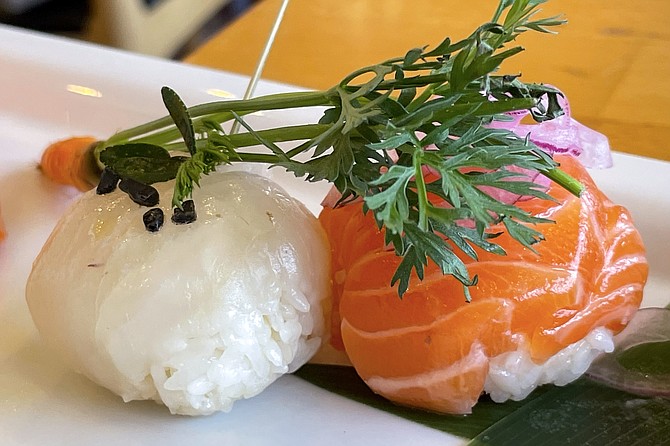
There is a lot going on at 4646 Convoy Street, suite 101. I was here just a couple months ago to try the Japanese style fried chicken of Junya’s Crispy Karaage. That counter shop shares an extended space with RakiRaki Ramen, and both share a shaded dining patio with vegan sushi spot, The Yasai. These are all part of a growing family of eateries opened by chef, and restaurant impresario, Junya Watanabe.
Watanabe is calling the cluster of restaurants RakiRaki Commons, and this day, I’ve shown up to check out the latest to join the group: Matsuoka.
Created with resident sushi chef and restaurant namesake, Hajime Matsuoka, Matsuoka is actually a restaurant within a restaurant — though not vegan, it operates within the same space as The Yasai.
But the Commons are even more interconnected than that. When I show up at the hostess stand, she tells me it’s a fifteen-minute wait for RakiRaki. But for Matsuoka I can be seated immediately. Keep this in mind, because once seated, I’m handed a collection of menus covering all four restaurants, and told I can order from each or all of them. It doesn’t seem to matter where you sit. Which is great, especially if everyone in your party wants different meals. But there’s more than enough happening at Matsuoka. Beginning with temarizushi.
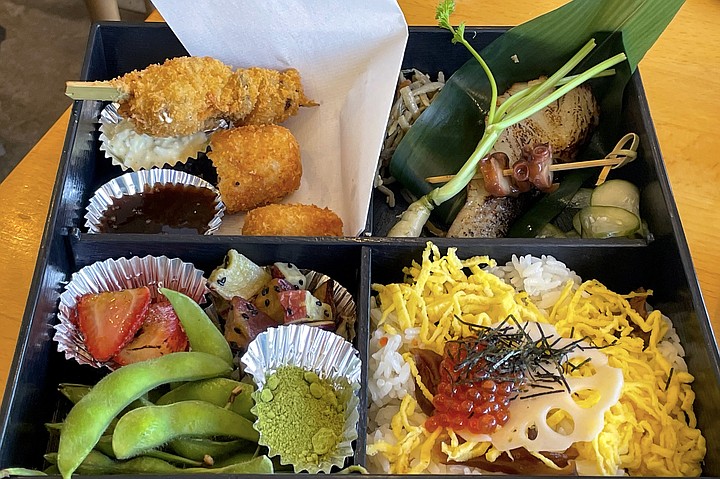
In Japan, temari are colorful, embroidered toy balls — comparable to hacky sacks, but much prettier. So whereas the familiar nigiri sushi is made by pressing sliced fish over an oblong patty of rice, temari sushi sees the fish laid atop spherical balls of rice. They are, quite literally, sushi balls.
The main difference between these sushi styles, then, are their shapes. For lunch at Matsuoka, each sushi order features one piece of nigiri, and one piece of temari, allowing me to try them side by side. For most of the usual fish — bluefin tuna, salmon, yellowtail, etc. — it’s $7 for the two, Premium items such as fatty tuna and sea urchin go for $15.
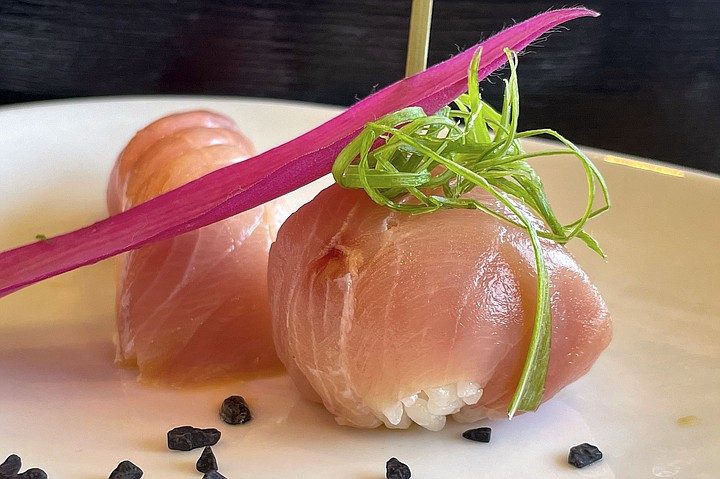
Each pair of sushi morsels comes garnished in some way. My salmon pieces are joined on the plate by an adorable, color-coordinated baby carrot, greens still attached. The sushi pieces featuring snow crab are plated with the crab’s recently emptied leg shell.
This attention to presentation is a theme at Matsuoka. The temari balls may provide more of a mouthful than their corresponding nigiri, but most differences are mainly aesthetic. They both feature the same, quality cuts of fish, after all. If you really want to impress someone, contact the restaurant ahead of time to order a temari bento. This labor intensive box features sixteen balls, colorfully arranged like a box of gourmet confections. It’s nothing short of dazzling.
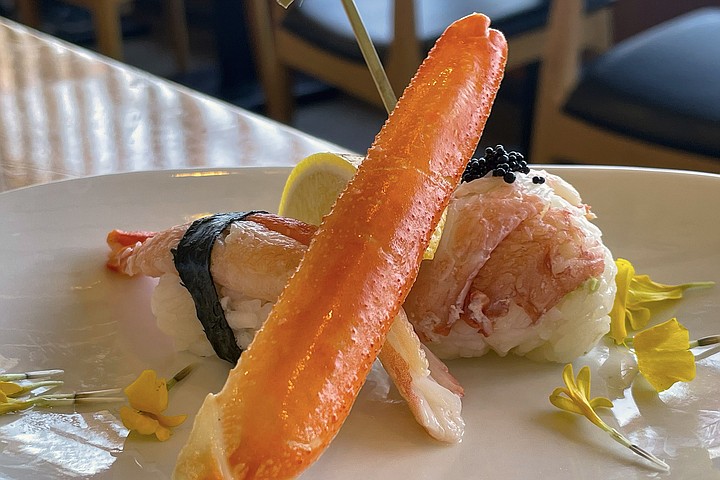
The bento box concept makes up the other key component of Matsuoka’s menu. Most bento boxes around town feature a main entrée supported by California rolls, gyoza, salad, and miso soup. These “premium” bento boxes go a somewhat different direction. They’re labeled as kaiseki boxes, using a term that refers to a multi-course meal of small plates — akin to the concept of a tasting menu. In bento form, Matsuoka interprets this a few different ways. One box is built around a chirashi bowl, displaying an assortment of cubed fish over rice. Another acts as a de facto sushi combo, featuring a variety of nigiri.
The yakizakana, or grilled fish boxes, offer a choice of grilled salmon, yellowtail collar, or miso-marinated black cod. The closest in concept to the customary bento, this one features a rotating assortment of chef’s choice sides. Expect the likes of panko-fried shrimp and pork belly, caramelized fruit, rice, edamame, and yes, miso soup (with mushrooms).
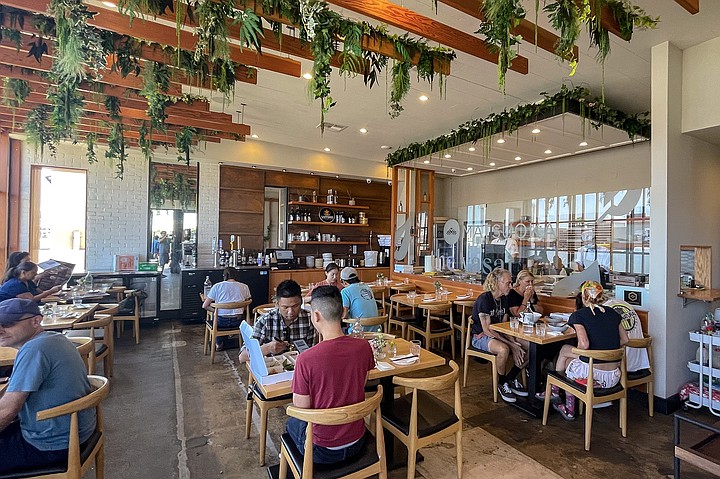
Mine, featuring black cod, happened to come with potato three ways: tempura, roasted, and potato salad. Any one of these would have been fine, but given the bento box price of $28, I could have done with less potato and more fish.
Or, maybe I’m spoiled by the value of Watanabe’s other concepts, so visible on the menus before me. The cluster of counter shops deliver mochi infused noodles, pasture raised chicken, and heritage pork. If you’re on a budget, stick to these fast casual, budget friendly options. If you’re out to win over your dining companions with slowly constructed plates that reveal a flair for artistry, that’s what you’re paying for at matsuoka.


There is a lot going on at 4646 Convoy Street, suite 101. I was here just a couple months ago to try the Japanese style fried chicken of Junya’s Crispy Karaage. That counter shop shares an extended space with RakiRaki Ramen, and both share a shaded dining patio with vegan sushi spot, The Yasai. These are all part of a growing family of eateries opened by chef, and restaurant impresario, Junya Watanabe.
Watanabe is calling the cluster of restaurants RakiRaki Commons, and this day, I’ve shown up to check out the latest to join the group: Matsuoka.
Created with resident sushi chef and restaurant namesake, Hajime Matsuoka, Matsuoka is actually a restaurant within a restaurant — though not vegan, it operates within the same space as The Yasai.
But the Commons are even more interconnected than that. When I show up at the hostess stand, she tells me it’s a fifteen-minute wait for RakiRaki. But for Matsuoka I can be seated immediately. Keep this in mind, because once seated, I’m handed a collection of menus covering all four restaurants, and told I can order from each or all of them. It doesn’t seem to matter where you sit. Which is great, especially if everyone in your party wants different meals. But there’s more than enough happening at Matsuoka. Beginning with temarizushi.

In Japan, temari are colorful, embroidered toy balls — comparable to hacky sacks, but much prettier. So whereas the familiar nigiri sushi is made by pressing sliced fish over an oblong patty of rice, temari sushi sees the fish laid atop spherical balls of rice. They are, quite literally, sushi balls.
The main difference between these sushi styles, then, are their shapes. For lunch at Matsuoka, each sushi order features one piece of nigiri, and one piece of temari, allowing me to try them side by side. For most of the usual fish — bluefin tuna, salmon, yellowtail, etc. — it’s $7 for the two, Premium items such as fatty tuna and sea urchin go for $15.

Each pair of sushi morsels comes garnished in some way. My salmon pieces are joined on the plate by an adorable, color-coordinated baby carrot, greens still attached. The sushi pieces featuring snow crab are plated with the crab’s recently emptied leg shell.
This attention to presentation is a theme at Matsuoka. The temari balls may provide more of a mouthful than their corresponding nigiri, but most differences are mainly aesthetic. They both feature the same, quality cuts of fish, after all. If you really want to impress someone, contact the restaurant ahead of time to order a temari bento. This labor intensive box features sixteen balls, colorfully arranged like a box of gourmet confections. It’s nothing short of dazzling.

The bento box concept makes up the other key component of Matsuoka’s menu. Most bento boxes around town feature a main entrée supported by California rolls, gyoza, salad, and miso soup. These “premium” bento boxes go a somewhat different direction. They’re labeled as kaiseki boxes, using a term that refers to a multi-course meal of small plates — akin to the concept of a tasting menu. In bento form, Matsuoka interprets this a few different ways. One box is built around a chirashi bowl, displaying an assortment of cubed fish over rice. Another acts as a de facto sushi combo, featuring a variety of nigiri.
The yakizakana, or grilled fish boxes, offer a choice of grilled salmon, yellowtail collar, or miso-marinated black cod. The closest in concept to the customary bento, this one features a rotating assortment of chef’s choice sides. Expect the likes of panko-fried shrimp and pork belly, caramelized fruit, rice, edamame, and yes, miso soup (with mushrooms).

Mine, featuring black cod, happened to come with potato three ways: tempura, roasted, and potato salad. Any one of these would have been fine, but given the bento box price of $28, I could have done with less potato and more fish.
Or, maybe I’m spoiled by the value of Watanabe’s other concepts, so visible on the menus before me. The cluster of counter shops deliver mochi infused noodles, pasture raised chicken, and heritage pork. If you’re on a budget, stick to these fast casual, budget friendly options. If you’re out to win over your dining companions with slowly constructed plates that reveal a flair for artistry, that’s what you’re paying for at matsuoka.
Comments